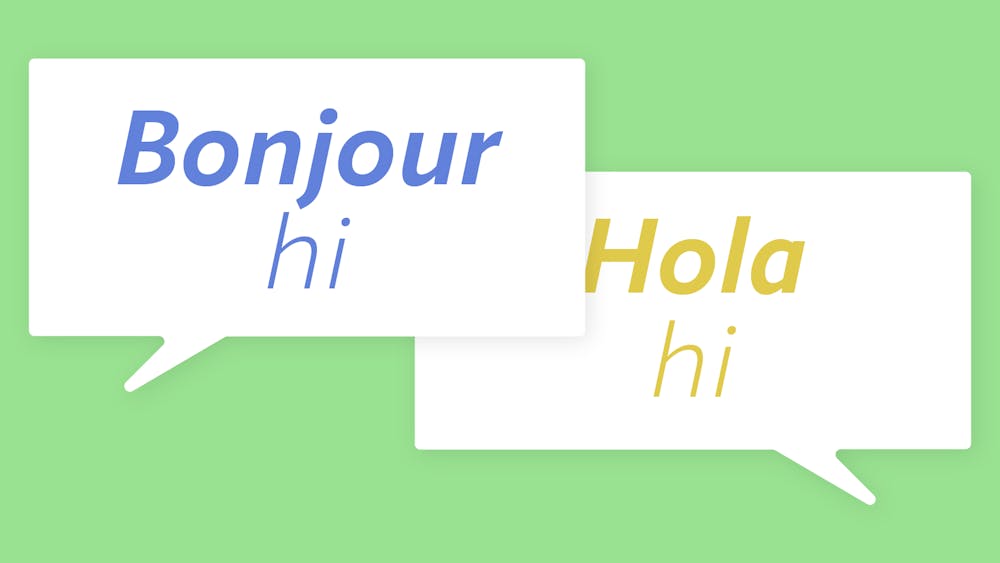
“Hello.” “Hello.”
That’s a pretty normal way to begin a conversation here at Penn. However, that’s just one option. One of the most intriguing alternatives comes from the Canadian province of Québec: “Bonjour-hi,” to which “Hello” is just one of many responses.
The form of the word bonjour-hi gives some clues about how it works as a greeting. It’s really two greetings combined into one — a bonjour, for people who want to speak French, and a hi, for people who want to speak English. The response says which language to speak in.
Bonjour-hi, however, also plays a political role. Québec is the center of Canada’s Francophone culture, which feels itself under siege from a wave of English domination. Consequently, bonjour-hi keeps a spot for French in public space, but it isn’t enough to satisfy some Québécois nationalists, who consider it an unfair capitulation to English.
There are only two choices with bonjour-hi. However, in other countries people have adopted different systems where people bargain about what language to talk in; somebody leads with a greeting in one language, and the other person responds in the same, if that is acceptable, or responds with a different one, to switch it.
Yet pretty much every conversation that I have ever had or heard in the United States starts in English and ends in English. Google only produces a few irrelevant results for hola-hi or hi-hola, and bonjour-hi hasn’t made it across the northern border, as far as I can tell.
The simple answer to why this happens is that the U.S. is a monolingual country, unlike bilingual Canada. However, this isn’t entirely true. Although bonjour-hi is principally used in Québec, the center of Canada’s Francophone culture, it also pops up occasionally elsewhere, such as in a part of Nova Scotia with English multilinguals. 89% of Nova Scotians don’t speak French, and over 99% can carry on a conversation in English. Furthermore, after Québéc, no province has more than nine percent French monolinguals.
Meanwhile in the U.S, 14% of Americans speak Spanish at home. 45% of Californians and 12% of Pennsylvanians speak a language other than English at home. There are more Spanish speakers in the U.S. than in Spain itself. It demonstrates that what Canada uses to create a bilingual atmosphere could also work in the similar environment of the U.S.
Furthermore, the U.S. is continually trending toward bilingualism, at least at home. Thus institutions at all scales, from the U.S. government to Penn, are faced with a choice: embrace the hidden bilingualism of the United States, or continue to maintain a de facto policy of English monolingualism.
Both choices are certainly possible, but I’d encourage bilingualism. A large body of linguistics research has shown that bilingualism offers cognitive benefits, while concerns about bilingual children not learning both languages well have been proven unfounded. Furthermore, having a language in common connects us to the rest of the world. Other benefits are too numerous to list, but here’s one more: Canadian bilinguals earn more than people who only speak English.
On the other hand, machine translation can sometimes serve as an alternative to actually knowing a language. However, it’s often riddled with errors, especially in lesser-studied languages; you can check this out for yourself. Additionally, while monolingualism does lessen the need for translation services, there are enough Americans who need them that the danger of excluding people who do not speak English is greater.
One approach to making the U.S. more multilingual is to make more Americans multilingual through increasing multilingual education, but that’s only half of the story, given that the U.S. actually has a large Spanish-speaking population. The other part is about activating the U.S.’s hidden multilingualism and preventing people from losing languages through ways like reducing biases against accents that indicate speaking other languages.
To unlock this reserve, I’d suggest implementing a bonjour-hi, or rather hola-hi, policy in the United States. Although the Canadian version hasn’t satisfied many Québécois nationalists, it logically still puts conversations in the language best suited to them. An additional benefit for Americans is that making it a norm, if done well, could prevent people from picking what language to use based on stereotypes.
However, the U.S. can still improve on bonjour-hi in a few ways — hola-hi (or hola-hello) if Spanish is preferred, hi-hola if English is preferred, and just hi for people like me who speak pretty much no Spanish yet. Furthermore, there’s no end to how many languages this system could support; I could greet my friend with “Hello-hallo-salvē” and he could respond with “Hello-hola-salvē” indicating a conversation that should probably happen in English, but could theoretically also take place in Latin.
However, language doesn’t change by sheer force of will. The U.S. government and other major institutions could begin to encourage the use of compound greeting, unlike their Québécois counterparts. From here compound greetings would have a solid base to spread into universities like Penn and finally into everyday life, showcasing that the U.S. isn’t as Anglophone as it appears.
I’m hopeful that, in the future, fewer conversations are going to begin with a simple “Hello.” “Hello.” But this will take work to undo the current dominance of English. When that happens, there’ll be a whole new world waiting out there, full of multilingualism for people who want to broaden their horizons beyond “Hello.”
BENJAMIN McAVOY-BICKFORD is a College first-year from Chapel Hill, NC. His e-mail is bmcavoyb@sas.upenn.edu
The Daily Pennsylvanian is an independent, student-run newspaper. Please consider making a donation to support the coverage that shapes the University. Your generosity ensures a future of strong journalism at Penn.
Donate







